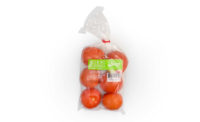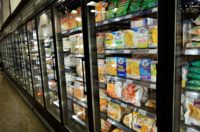The topic of food waste has grown into a significant, high-profile issue over the past decade, with more attention paid to the problem as a part of the larger climate change conversation. Volume foodservice like hotels, catering, restaurants and cruise ships have made significant progress through a more cautious assessment of how much food they actually prepare and serve—which has a ripple effect on reducing the amount of food sourced as well—but on the homefront, the topic is still confusing to many consumers, who throw out about 25% of their perishable purchases annually.
While packaging technology like HPP (high-pressure processing) helps to extend the life of refrigerated foods like salsas, guacamole, ready-to-eat meals and fresh-pressed juices, nothing matches the lifespan of frozen foods. With that longevity comes the subsequent benefit of reduced food waste, but that reduction actually starts long before a product is purchased. I sat down with Alison Bodor, president and CEO of the American Frozen Food Institute (AFFI), to discuss the layers and logistics involved in frozen foods, and how they impact food waste.
R&FF: What role does frozen food play in helping to mitigate food waste overall?

Alison Bodor is president and CEO of The American Frozen Food Institute (AFFI) in Arlington, Virginia.
We know that freezing food is a valuable solution to reducing food waste at the consumer level. Through AFFI’s consumer research we found that consumers recognize they are major contributors to food waste with half of respondents admitting they waste 30% or more of the food they purchase in a typical week.
The majority of Americans we surveyed would freeze food to reduce food waste and would purchase frozen food in order to lessen their personal food waste. Of course frozen food has a long shelf life, so in today’s COVID-19 world, frozen food is good for that purpose plus it helps extend the time between grocery trips.
The convenient thing about frozen foods, especially fruits and vegetables, is that you typically only prepare the amount you plan to eat at a certain meal occasion. Other foods, like entrees, are naturally portion controlled. Our industry has been working to educate consumers about how to incorporate more frozen fruits and vegetables, in addition to their fresh selections, to achieve the goal of eating more overall fruits and vegetables in line with health recommendations, but also to protect that produce from ending up as waste. Fresh produce is otherwise one of the top contributors to food waste.
R&FF: Why has awareness of food waste become more prominent in recent years?
Industry, consumer groups, and government are all taking action. Organizations, like the Natural Resources Defense Council (NRDC) and ReFed just to name a few, and federal agencies and academia are also sharing staggering statistics that quantify
food waste.
The USDA estimates food loss and waste from the food supply at the retail and consumer levels was 31% of the food supply, equaling 133 billion pounds and almost $162 billion. At the same time, 1 in 7 people in the U.S. were food insecure before the pandemic and that figure has definitely increased now. Buying frozen foods, and wasting less food, could only change those numbers for the better. Research published in the British Food Journal shows that frozen foods generate 47% less food waste in the home compared to ambient and chilled food.
Other reasons food waste has become more prominent is because environmental issues and sustainability are top of mind for consumers, especially millennials. According to the International Food Information Council’s (IFIC) consumer survey, one in four consumers are paying more attention to the amount of food wasted from meals eating at home, while 19% are paying more attention to the type of packaging used in products they’re buying and 17% are doing the same when it comes to the amount of packaging used in products they purchase. Food waste also contributes to greenhouse gas emissions. According to USDA and EPA, food waste is one of the top components of U.S. landfills.
It’s a waste of resources to grow food that is then discarded. Land, water, labor, energy and other inputs are used in producing, processing, transporting, preparing, storing, and disposing of discarded food. It’s estimated that 21% of fresh water is used on food that is never consumed. It’s unfortunate to waste these precious resources.
R&FF: What are some other ways frozen food manufacturers can help reduce food waste through sourcing and during the production of their products?
Sell by? Best by? Use before? There are multiple labels on food packaging, and it’s difficult to keep them all straight. It’s no wonder that confusion over food labels accounts for as much as 20% of consumer waste. That’s why AFFI supports using the “BEST if Used By” and “USE By” labels. The “BEST if Used By” label will indicate to consumers that after the specified date, the product may not taste or perform as expected but is still safe to consume. The “USE By” date will inform consumers that the products should be consumed on or before the date listed on the package.
R&FF: What role does government play in mitigating food waste as it pertains to the frozen food industry?
Industry, consumer groups, and government are all taking action. Led by the USDA and EPA, the federal government is working with communities, organizations, businesses and states to provide them with tools and resources to reduce food waste by 50% by 2030. The Food Waste Reduction Alliance (FWRA) is an industry-led initiative led by The Food Industry Association, The Consumer Brands Association, and the National Restaurant Association that is focused on increasing food donations of wasted food and recycling unavoidable food waste into soil or energy. And, charities like Feeding America are working to divert food that might otherwise be wasted to Americans in need. The AFFI has a page dedicated to food waste resources on our website.
R&FF: Since this is an election year, what effect would a Biden administration have on frozen foods and food waste?
The Biden administration has a plan for a modern, sustainable infrastructure and an equitable clean energy future which would have implications for the broader food and beverage industry. A component of this plan is the creation of new revenue streams for farmers in energy and waste products and growth of bio-based manufacturing jobs. This plan would likely increase the spotlight on conservation broadly, including industry efforts to mitigate food waste through sourcing and processing operations. As I mentioned earlier, frozen food generates 47% less food waste when compared to ambient and chilled food consumed in the home, so already, the frozen food industry is well positioned for this dialogue.
Regardless of which presidential candidate prevails in November, AFFI will work to ensure policymakers understand the role frozen foods can play in helping us achieve shared policy goals, like improving resource conservation, helping feed a growing world and ensuring more people have access to affordable, safe and nutritious foods.





